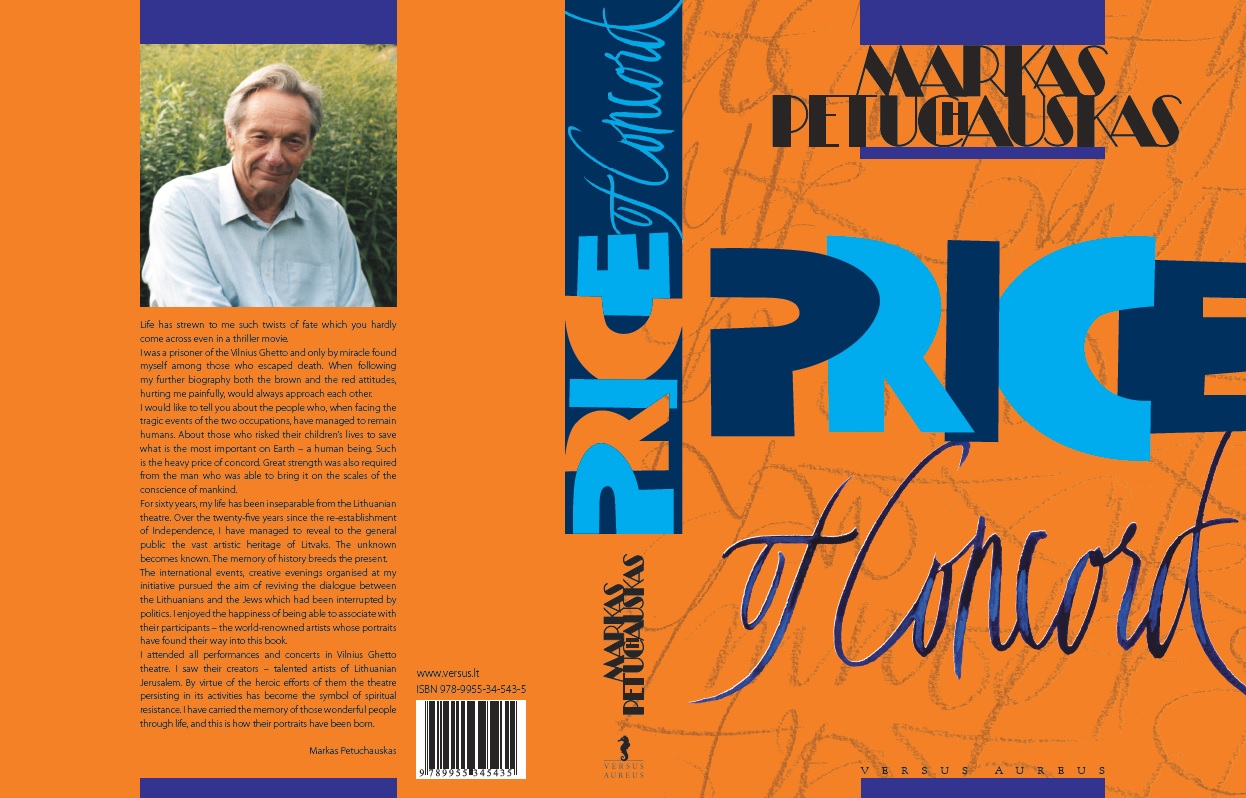MEMOIRS
PORTRAITS OF ARTISTS
INTERACTIONS OF CULTURES
Author: habil.dr. prof. Markas Petuchauskas
The life of Markas Petuchauskas, a former Vilnius Ghetto prisoner, famous theatre historian and critic, is marked by twists of fate rarely seen other than in dramatic theatrical portrayals. His survival could well be seen as a miracle as he joined the rare few who managed to escape the death that accompanied the Nazi ghettos.
With a special poignancy, the author describes how extraordinary human beings were able to retain their humanity and dignity in spite of the horrific Nazi and Soviet occupations of Lithuania. He speaks of those who risked their and their children`s lives to protect that which they valued above all else on Earth – the life of another human being.
By attending the many performances and concerts that took place in the Vilnius Ghetto theatre, from his earliest years, he came to know and appreciate the art and its creators – talented artists of Jerusalem Lithuania – and this powerful memory permeates the pages of the ‘Price of Concord’. Presented on a broad cultural canvas, the vast artistic heritage of Litvaks is revealed in the book, with the unknown becoming known and memory becoming present.
Over the last 25 years the reminiscences were supplemented by the author`s consistent on-going research and personal associations. This can been seen in the portraits of Avrom Sutzkever, Szmerl Kaczerginski, Yisroel Segal, Liuba Lewicka, Rozental family (Chaje, Leib and Naava Piatka), to name but a few, which have found their way into the book. Alongside of them stand the silhouettes of Litvaks, great world figures, such as Chaim Soutine, Jacque Lipchitz, Ben Shahn, Neemija Arbit Blatas, Romain Gary, Emannuel Levinas, Jascha Heifetz. Of very special importance, over the period spanned by these memoirs has been the joy and happiness of being able to associate with world-renowned artists such as Czeslaw Milosz, Claude Lanzmann, Joshua Sobol, Alexander Tamir, Samuel Bak, Yuri Lyubimov, Georgy Tovstonogov and etc. Their portraits emerge in this book, as well.
For sixty years the author`s life has been inseparable from Lithuanian art. He has published more than three hundred articles and books on Lithuanian theatre. He had the opportunity to communicate with and know such eminent figures of Lithuanian culture as Petras Kubertavičius, Viktoras Dineika, Romualdas Juknevičius, Juozas Miltinis, Henrikas Vancevičius, Donatas Banionis, Regimantas Adomaitis, Saulius Sondeckis, Juozas Grušas, Eduardas Mieželaitis, and Just. Marcinkevičius. Essays about them have rightfully found a place in this book.
The ‘Price of Concord` representation of interactions between the Lithuanian and the Jewish cultures, with the aspirations of reviving the dialogue between the representatives of these nations which were interrupted by two occupations, provides a rich look into the cultural complexities of these periods and some of their on-going implications.
The Jewish Cultural Club of Lithuania (1994-2008), established and led by Petuchauskas, engaged in a number of large international projects: the Poetry Days devoted to Nobel Prize laureate Joseph Brodsky (1996); Vilnius Violin Days in honour of Jascha Heifetz (2001); the International Art Days dedicated to Vilnius Ghetto Theatre (1997; 2002); Cultural Days devoted to Litvak philosopher Emmanuel Levinas (2006). Prominent artists from France, Germany, Poland, Czech Republic, USA and Israel participated in numerous arrangements of the ‘Days.’
The ‘Price of Concord’ gives special attention to the Vilnius Ghetto theatre, with its presentation of the culture of Lithuanian Jerusalem on its cramped little stage. By virtue of the heroic efforts of artists, the theatre had become the symbol of spiritual resistance under the cruel circumstances of Nazi terror. Petuchauskas was the first to speak out and draw attention to its artistic and cultural significance, previously only known to scholars of the period. Through his life’s work, he has brought attention to this unique European phenomenon of theatre art, with all its creative energy and importance under such extraordinary tragic circumstances. It was the center of spiritual resistance in the Vilnius Ghetto.
Furthermore, the book calls attention to the fact that since the Middle Ages and the times of the Grand Duchy of Lithuania, Vilnius has been famous as an important, multinational and multicultural European city spreading and fostering tolerance and traditions of mutual understanding. In the spiritual strength of the Vilnius Ghetto and the historical role played by the Ghetto theatre, one can see the glow of the ideas of the unification and mutual understanding that grew and became ever stronger. In response to the experience of the Holocaust and Nazism, aspirations of unification and forbearance were awakened, with a deepened commitment to the shared principles of Western democracy.
The book (488p.) is illustrated with approximately 260 photos and annotated with broad and keen-witted commentaries. They are an important and welcomed integral continuation of the author`s recounts.


